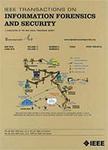版权所有:内蒙古大学图书馆 技术提供:维普资讯• 智图
内蒙古自治区呼和浩特市赛罕区大学西街235号 邮编: 010021

作者机构:Beijing Inst Technol Sch Opt & Photon Beijing 100081 Peoples R China Chinese Acad Sci Inst Automat Key Lab Multimodal Artificial Intelligence Syst New Lab Pattern Recognit NLPR Beijing 100190 Peoples R China Hunan Univ Sch Elect & Informat Engn Changsha 410082 Peoples R China Beijing Univ Posts & Telecommun Sch Artificial Intelligence Beijing 100876 Peoples R China
出 版 物:《IEEE TRANSACTIONS ON INFORMATION FORENSICS AND SECURITY》 (IEEE Trans. Inf. Forensics Secur.)
年 卷 期:2025年第20卷
页 面:1192-1205页
核心收录:
学科分类:0808[工学-电气工程] 08[工学] 0812[工学-计算机科学与技术(可授工学、理学学位)]
基 金:National Natural Science Foundation of China [6247076950 62071468 62276263]
主 题:Face recognition Translation Feature extraction Vibrations Faces Optical imaging Frequency-domain analysis Mathematical models Optical reflection Lighting Cross-property translation polarization face anti-spoofing generative model
摘 要:Despite the development of spectral sensors and spectral data-driven learning methods which have led to significant advances in face anti-spoofing (FAS), the singular dimensionality of spectral information often results in poor robustness and weak generalization. Polarization, another fundamental property of light, can reveal intrinsic differences between genuine and fake faces with advantaged performance in precision, robustness, and generalizability. In this paper, we propose a facial image translation method from visible light (VIS) to polarization (VPT), capable of generating valuable polarimetric optical characteristics for facial presentation attack detection using VIS spectrum information input only. Specifically, the VPT method adopts a multi-stream network structure, comprising a main network and two branch networks, to translate VIS images into degree of polarization (DoP) images and Stokes polarization parameters ${S}_{1}$ and ${S}_{2}$ . To further improve image translation quality, we introduce a frequency-domain consistency loss as a complement to the existing spatial losses to narrow the gap in the frequency domain. The physical mapping relations for the DoP and Stokes parameters are employed, and the Stokes loss is designed to ensure that the generated polarization modalities conform to objective physical laws. Extensive experiments on the CASIA-Polar and CASIA-SURF datasets demonstrate the superiority of VPT over other baseline methods in terms of polarization image quality and its remarkable performance in the FAS task. This work leverages the inherent physical advantages of polarization information in material discrimination tasks while addressing hardware limitations in polarization image collection, proposing a novel solution for face recognition system security control.